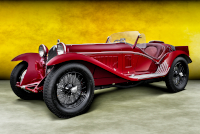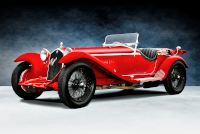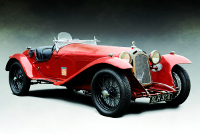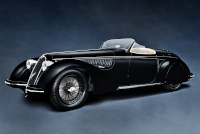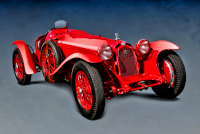Location:
Radnor Hunt Concours d'Elegance, 2016
Radnor Hunt Concours d'Elegance, 2015
Owner: Gordon Barrett (late) | Indianapolis, Indiana
Prologue:
Please note, Mr. Barrett sold chassis #2211071 discreetly in 2018, two years before he passed away. We take some opportunity in this piece to discuss his life and motorsport contributions.
The 8C 2300 Corto Touring Spider contains within its moniker that critical transposition of coachbuilder and body style, as if to credit the type to the carrozzeria rather than the manufacturer. This juxtaposition defines the pinnacle of 8C Alfa Romeo cars in the classic era, culminating in the 8C 2900B Mille Miglia Touring Spider, and including the production variants built on short and long chassis.
The style is not yet indicative of Modernist thinking, still appropriately dressed for a 1,000-mile race in the antique tradition, but picks up a few trends—the French sweep along the flank, dramatic cut-down door, chrome speedlines, and fascinating Hermes helmet shroud over the spares. So this design advances the road race concept over the spartan Zagato interpretation. And for this purpose, chassis #2211071 is the 1932 Paris Salon car.
With a few fortunate encounters following Mr. Barrett's restoration, I spent as much time as possible developing a gallery of perspectives, portraits, and internal details. And apart from the coachwork, I'm happy to depict the motor with high fidelity.
Having sourced a few recently published Alfa Romeo titles, I became astounded to see that they contain few, if any, motor images. I cannot fathom how one publishes a book about Alfa Romeo cars without depicting the motors. As if horsepower were a hypothetical concept. The casting technology is of an artistic merit equal to the coachwork, and one can see innovation in the motor's plan. It is not magic. So why would anyone miss the opportunity?
No doubt, it is the mechanicals that inspired Gordon Barrett, a long-time Indy race car engineer himself. So to look at his work—inasmuch as he channeled the spirit of Vittorio Jano himself—without focusing on these internals would be heresy.
- - - - - - - - - -
► Image Source: Nikon D750 (24.3 MP)
Images 1, 3-8, 10, 14, 18-20, 22-25: Radnor Hunt, 2015 | Images 2, 9, 11-13, 15-17, 21: Radnor Hunt, 2016
References:
- Czap, Nick. "Museo Storico Alfa Romeo: The catalogue" Giorgio Nada Editore, Milano, Italia. 2015, page 57
- Hales, Mark; Mason, Nick. "At The Limit: Twenty-one classic cars that shaped a century of motor sport" MBI Publishing Company, Osceola, WI. 1988, page 30, 35
- Autoweek: Tegler, Jan. "ESCAPE ROADS: 1932 Alfa Romeo 8C 2300 Spyder: Better than perfect" November 29, 2007. Perhaps the nicest write-up on #2211071, this article talks about the Mr. Barrett, his car, and their history.
- VeloceToday: Perhaps not a formally complete article, this 2018 piece by Geoffrey Goldberg is worth the review for its complimentary impression of Gordon Barrett.
- SpeedSport: "BOURCIER: A Toast to Gordon Barrett" by Bones Bourcier, October 1, 2020.
- Hemmings: Ernst, Kurt. 1932 Alfa Romeo 8C 2300 spider takes Best of Show at Radnor Hunt. September 21, 2015. This short piece comments on #2211071 after its Best of Show, Sport win at Radnor Hunt in 2015. An interesting balance, at 12cylinders we've taken some time to discuss both Mr. Gordon Barrett and Mr. Charles Gillet (whose Pierce-Arrow won Best of Show that year), as each man represents the best of a passing generation.
- TravelingWithTools: Mechanic Greg Stasko illustrates the nuances of Vittorio Jano's 8C motor in a way we simply cannot do from the outside.
Perhaps no classic embodies the character of a sports car better than the 8C 2300 Alfa. Of that illustrious line, the Mille Miglia Corto Touring Spider is the cover car—these words courtesy of popular so-say. The truth involves one part romance and many parts performance. Alfa's classic 8C is a nicely proportioned sports-racing car outfitted for a 1,000-mile race across Italy, wears blood red paint, and looks aggressive in short-chassis spider configuration. So the point is arguable, of course, but not without its own library of evidence.
Having dabbled in hyperbole, we must now grab the rope and haul in the fantasy. Certainly the opinion of 8C greatness is Italo-centric. The French and the English both enjoyed earlier international success, to say nothing of oft-overlooked American contributions that crossed the Atlantic and refined those early continental designs. But here, we mean to discuss the concept of a sports car that etched itself in stone and became the world's generally accepted definition. By those quasi-romantic standards, the 8C Alfa lays substantial claim to the title.
As fast as any road-going car of the decade—up to 135 miles per hour in good fettle, and at least 140 miles per hour in stripped-down Monza trim—the 8C owes its success to a supercharged, dual overhead-cam, straight 8-cylinder motor, balanced by the ingenious plan of dividing the block in half and driving the valves from a central gear train. The design comes from Vittorio Jano, with much of the chassis based on his outgoing 6C 1750, whereas the motor benefits from a succession of 8-cylinder grand prix cars dating back to the previous decade.
8C 2300 Alfa cars accumulated two consecutive Mille Miglia wins, four consecutive Le Mans 24-Hour wins, and two consecutive Spa 24-Hour wins, proving their sports-racing supremacy. With such a resume, the 8C 2300 will be outclassed only by development of the same motor; these are the concurrent P3, whose larger displacement and twin superchargers place Alfa in Grand Prix racing contention, and the 8C 2900, which becomes Alfa's premier, P3-based sports car at the close of the decade.
Chassis #2211071 appeared at the 1932 Paris Salon de l'Automobile. Its early life consisted of privateer racing and road use before crossing the Atlantic at the outset of World War II. The car resided in my home state of Maryland for 50 years before acquisition in 1991 by Mr. Gordon Barrett. His ensuing twelve-year restoration brought the car to the beautiful presentation depicted here. While concours events from Pebble Beach to Amelia island since confirmed this 8C Alfa's historical accuracy and perfect presentation, Mr. Barrett had no such aspirations other than to treat the machine as it should be treated. Furthermore he drove the car as intended, completing a good many 1,000-mile Colorado Grand events.
Gordon Barrett and the Alfa Romeo 8C 2300 Mille Miglia
A word on Mr. Barrett, of whom compliments of character and discipline emerged since his passing in 2020. His personal automotive history is rather embedded in the Indianapolis motor racing scene, his occupation, and his affinity for classic Italian machinery a long-standing avocation. Gordon Bennett was a reverent fan of Vittorio Jano, and being a mechanical engineer himself, took to collect, study, and use artefacts of Jano's development in his own shop. He seemed to internalize Jano's work such that his reconstitution of the 8C Alfa became the truest form of the original.
Through the 1970s, Barrett developed Indy racing cars for Grant King and A.J. Watson before moving on to indenpedent contracts with race teams and specialty producers. He maintained his own shop in Indianapolis, which is where he restored Alfa Romeo 8C chassis #2211071.
Purchased in 1991, the twelve years Barrett spent restoring the Alfa passed without much notice, being that he worked in his own quiet manner. He had not been a part of the concours scene and harbored no aspirations of joining that crowd, so when he did take the car to Pebble Beach in 2005, he surprised a lot of people.
The parroted story goes that Pebble Beach judges award this 8C 2300 MM an extra half-point above a perfect 100, such is the meticulous quality of Barrett's work. In recollections by Geoffrey Goldberg, Barrett describes the circumstance. "He explained that the Alfa was largely unknown; it had been in the hands of a dentist he knew in a barn garage for about 30 years, from his youth near where he had lived in Pennsylvania. It was not on anyone’s radar, and with an additional decade or two of Gordon’s restoration, it was simply new to the Alfa community. Gordon’s restoration had been meticulous, and he shared stories of visiting junkyards in Italy. In one he was able to find the correct pulley for the brake cables."
By the time Mr. Goldberg caught up with Gordon Barrett in 2018, #2211071 had just moved on. "Gordon explained he had done about eight Alfa rallies with the car, and he felt the car would only go downhill if he kept using it. He had just made the unusual and courageous decision to part with it. This was a strange decision for it was truly one of, if not the best in the world. In true Gordon fashion, he made the move with finesse and total discretion; he traded it for a user 8C, one with perhaps a bit less charm, a bit less perfection, but broken-in and well-appreciated. He took the difference and put it into a retirement fund. He was to receive the replacement 8C within a few days, and was eager to see how he would enjoy it. It was an odd move, to be sure, but upon reflection, made a great deal of sense."
Barrett also owned a handsome 6C 1750, a Lola T70, and a period California custom hot rod from the 1950s. Given his association with Indy racing, this assortment seems on-point in terms of speed and style, favoring ingenuity ahead of reputation, whether American, British, or Italian.
Motor: 2,336 cc, straight 8-cylinder, alloy block, aluminum hemi-head | 65 mm x 88 mm | 6.6:1 compression | motor #2211071
Vittorio Jano's race-prepared 8C motor uses a magnesium crankcase with aluminum main caps. On the case sit two aluminum cylinder blocks with iron liners, topped by a separate cylinder head formed in two 4-cylinder sections.
As we've taken the time to properly inspect the motor, I will insert here a spot of Mark Hales' exceptional prose: "A fluted, curved, rounded piece of foundryman's art with eight boreholes. A sculpture in aluminium that looks like chromium-plated marble, picked out with little inspection covers, each held with chromed and domed fasters. The sort of thing accountants would replace with pieces of pressed tin. And nestling alongside this piece of automotive expression is another anachronism. A supercharger, driven by a shaft and gears rather than any piece of rubber belt. An aluminium pump, scalloped and polished to match the engine and to feed those eight cylinders with more petrol than they can suck for themselves. Feeding that diet of fuel and air not through a plastic pipe linked by rubber hoses, but by a specially cast tunnel whose fins lie in perfect symmetry with those on the engine behind it. And all this for just 2.3 litres."
Valvetrain: DOHC, 2 valves per cylinder, gear-driven via a central mechanism between each 4-cylinder block
The center of the crankshaft uses a sprung gear hub to control tolerance between both halves. Each camshaft is two pieces joined at the cam gear in the middle.
Aspiration: Memini S152 carburetor, Roots-type supercharger
Power: 155 bhp at 5,200 rpm
Drivetrain: 4-speed gearbox, rear-wheel drive
Front Suspension: beam axle, semi-elliptic leaf springs, friction dampers
Rear Suspension: live axle, semi-elliptic leaf springs, Siata shock absorbers
Architecture: pressed steel chassis (described by the factory as "longerons and cross members in pressed steel," a 'longeron' being an aviation term for a stressed, load-bearing stringer) with aluminum coachwork by Touring Superleggera of Milan
Kerb Weight: 1,000 kg (2,205 lbs)
Wheelbase: 2,750 mm (108.3 inches)
0-60: 9.4 seconds
Top Speed: 185 km/h (about 115 mph)
Etymology:
'8C 2300' refers to the motor, a straight 8-cylinder of about 2.3 litres displacement. 'Corto' refers to the short chassis, (as opposed to 'lungo'). The Mille Miglia moniker references Alfa's recent dominance in the 1,000-mile race, though ironically, the first group of 8C 2300 cars arrived too shortly before the 1932 race and had not been well enough prepped or tested to compete, leaving the business of actually winning the race until the 1933 and 34 editions. The term 'spider' descended from the carriage trade, which in motorcar parlance came to refer to open sports cars. To say "Touring spider" is common for Touring-bodied cars, rather than, "a spider by Touring."
Figures:
The Alfa Romeo factory cites 308 total 8C 2300 cars produced between 1931 and 1934. There are, however, so many variants built for different purposes and bodied by different coachbuilders that the number of Corto Mille Miglia spiders is relatively small. In our Alfa Romeo portfolio, we're fortunate to show Catasgna, Touring, and Zagato versions of the short chassis 8C; this does not prove that they are plentiful, merely that they are noteworthy enough to arrive on scene.
Hermes Helmet: Hallmarks of the Touring-Bodied 8C 2300 Mille Miglia
The Touring Spider's defining feature is the winged, aerodynamic shroud on the rear deck. Shaping airflow over the twin spares kit, the shroud sports a short dorsal fin and divides the top deck into two stowage compartments, each secured by leather straps. We've begun this gallery with tail perspectives and portraits to place the focus on these key features.
Compared to the Zagato-bodied spider, Touring's design uses more prominent speedlines on the running gear, along with a sharp French sweep down the flank. Despite the apparent simplicity of the overall shape, images 9 through 13 demonstrate how complex the curves become through the hips and tail, aft of the doors. Our view down the flank depicts the conjunction of these curves, along with the contrasting linearity of speedlines and bonnet louvres.
Crackle Cockpit: 8C 2300 MM Dashboard Survey
The crackle finish dashboard is original to the car, and perhaps reminiscent of the mid-century Aston Martin racers (like the DBR1), so far as I have seen. Jaeger provides the gauges, each trimmed in nickel. Bosch provides the ignition. Note that the speedometer hides under the cowl behind the wheel, but that the tachometer sits (crucially) in plain view of both driver and ride-along mechanic. Equally vital, the oil pressure gauge sits to the left of the tach. Less interesting, though perhaps still important, note that the wiper motor sits under the cowl, rather than against the windscreen.
Aftermarket Kit: Siata Adjustable Suspenion and Deviolux Lighting Components
Classic car folks will notice a Siata knob below the dash. Before Siata manufactured cars in their own right, the company provided performance parts for Italian sporting marques. The knob reads, "Regolatore a Distanza," which is an antiquated way of saying 'remote controller' in Italian. As indicated by the term, 'Posteriore,' over the white Siata badge, the knob controls the ride adjustment for a set of rear Siata shock absorbers, which would have been an advantageous feature for a public roads event such as the Mille Miglia.
While Bosch supplies the lights, the lamp rack includes distinct Deviolux plaques, which likely refer to the light switch relays. Perhaps it is somewhat odd that the maker's badge appears prominently on the stanchions, whereas the noteworthy Touring Superleggera badges sit neatly on the flanks below the footwell vents.
Fuse Box: Describing the 8C 2300 Fuse Box
Speaking of electrics, looking further into the motor along the bulkhead, we can read from the fuse box plate, from left to right: electric horn (avvisatore elettrico), instrument panel lights (lampadine quadro), coil ignition (bobina), auxiliary headlamps (lamp ausil faro destro), and foot switch (commutatore a pedale). This assortment differs from the car's 6C 1750 predecessor, which can be reviewed in our profile of chassis #8513045. The bulkhead itself is very similar, though the fuse box moved from the left side to the right.
Glorious Alloy: Vittorio Jano's Supercharged 8C 2300
Under the bonnet we find a collection of pieces more fantastically modern that the car surrounding it. While distinguishable as a twin-cam motor, the central valve gears create a radical bulge across the middle of the block. This arrangement allows Alfa to build each camshaft in two pieces, avoiding the torsional deformation that plagues high-performance straight 8-cylinder plans. The intake manifold, ribbed and flowing from the Roots supercharger, has become iconic of the breed, derived from previous Alfa race cars as well as the 6C line. The supercharger sits alongside the block, whereas blown 6C cars attach the supercharger to the front. The single Memini carburetor draws air through a mesh filter, an improvement over the more primitive semilunate metal cover. And we should discuss the Avvertenze (warnings) plate on the right of the cam cover, which provides the firing order (1, 3, 6, 8, 4, 2, 7, 5) and guidance on how to check valve clearance.
The dearth of motor images in recently published Alfa Romeo books is criminal. Aesthetically, these motors combine texture and shape in ways that few contemporary automakers achieved. If we think of those who obsessed over motor design and finish—namely Bugatti, Maserati, and Miller—then Alfa Romeo perhaps approaches the middle name in that trio. Here, the patina helps define the bolts, braces, and mix of surfaces. Adequate for racing, these surfaces will soon shine in grand touring form, augmented by subtle grey bulkheads, with metal plate and iron blocks painted in muted blue, teal, and aquamarine. These can be seen in the 6C 2300B Pescara Berlinetta Speciale and the 8C 2900B Lungo Touring Spider. It is equally important to watch the motor evolve in size, shape, and configuration as it is the car itself; I have tried to present the requisite visual context to do so.
Last Updated: Apr 18, 2025

